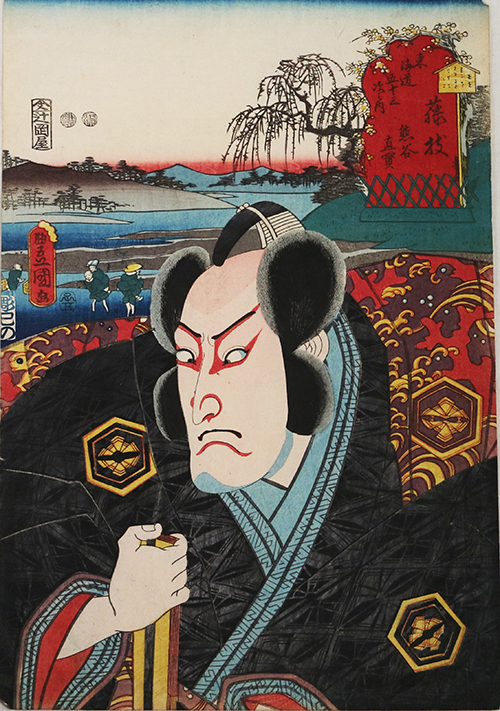資料名 |
Fujieda: Kumagai-Naozane, from the series “Fifty-three Stations of the Tōkaidō |
解説 |
Utagawa Kunisada(ToyokuniⅢ) Production date: 1852 (Kaei 5) In this series, linking the stories and customs of the post stations, popular actors of the time are illustrated with the background of the famous places. In Fujieda, there is the Renshouji Temple (sangou, the title prefixed to the name of a Buddhist temple of this temple is Kumagai-zan), which has a connection with Kumagai Naozane and he is chosen for this picture. This work is from the series “Actors Assorted in Fifty-three Stations of the Toukaidou ”. Right now 140 works of this series are found . The artist Toyokuni III is one of the most popular ukiyo-e artists. The landscape of the post station is illustrated at the background, and a figure in front is a character of kabuki play who has a connection to the post station. Also, the figure’s portrait is based on a famous kabuki actor. Utagawa Kunisada (Utagawa Toyokuni III) Tenmei 6~Genji 1 (1786~1864) Kunisada had a long career started from Bunka 4 (1807) till his death, became the most popular and successful ukiyo-e artist of that time. In the late Edo period, Kunisada’s reputation was far exceeded that of his contemporaries, more highly regarded than even Hokusai or Hiroshige. He was the most productive ukiyo-e artist and produced every genre of ukiyo-e. The pictures of beauties with his characteristic depictions of hunched back and short neck women were the dist inctive features of Kunisada’s style and a famous example was the picture of “Fraudulent Murasaki’s Bumpkin Genji”. In this series, linking the stories and customs of the post stations, popular actors of the time are illustrated with the background of the famous places. In Fujieda, there is the Renshouji Temple (sangou, the title prefixed to the name of a Buddhist temple of this temple is Kumagai-zan), which has a connection with Kumagai Naozane and he is chosen for this picture. And since Yoshitsune was the master of Naozane in the joruri play of “Ichi-no-tani Futaba Gunki (The War Chronicle of the Battle of Ichi-no-tani”), Yoshitsune was illustrated in the picture. |
資料番号 |
10711 |







